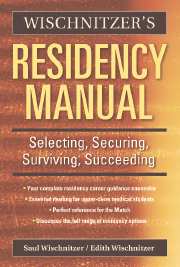Book contents
- Frontmatter
- Contents
- Tables and Forms
- Preface
- Message to the Reader
- Abbreviations
- PART ONE SELECTING A SPECIALTY
- PART TWO SECURING A RESIDENCY
- PART THREE SURVIVING A RESIDENCY
- 13 Becoming Oriented
- 14 Meeting Responsibilities
- 15 Protecting Your Assets
- 16 Professional Challenges Facing Residents
- 17 Personal Challenges Facing Residents
- 18 Surviving Yet Thriving
- PART FOUR SUCCEEDING IN PRACTICE
- Appendix 1 Major Professional Organizations
- Appendix 2 Sample Resumes
- Appendix 3 Personal Statement
- Glossary
- Bibliography
- Index
17 - Personal Challenges Facing Residents
Published online by Cambridge University Press: 08 August 2009
- Frontmatter
- Contents
- Tables and Forms
- Preface
- Message to the Reader
- Abbreviations
- PART ONE SELECTING A SPECIALTY
- PART TWO SECURING A RESIDENCY
- PART THREE SURVIVING A RESIDENCY
- 13 Becoming Oriented
- 14 Meeting Responsibilities
- 15 Protecting Your Assets
- 16 Professional Challenges Facing Residents
- 17 Personal Challenges Facing Residents
- 18 Surviving Yet Thriving
- PART FOUR SUCCEEDING IN PRACTICE
- Appendix 1 Major Professional Organizations
- Appendix 2 Sample Resumes
- Appendix 3 Personal Statement
- Glossary
- Bibliography
- Index
Summary
Overview
The composition of the resident population has undergone dramatic change over the past several decades. This is the result of the alteration in the makeup of medical school classes, which obviously directly influences the nature of the resident pool.
For well over a century medical school classes in the United States consisted, with few exceptions, almost entirely of white males. Acceptance of women into medical school was relatively meager until 1970, when a sustained increase in their numbers ensued. The road for women gaining admission to medical school has been long and difficult. The first woman medical student was Elizabeth Blackwell, who graduated from the then existing Geneva Medical College in 1849. She was followed by a handful of other women. The educational opportunities for women improved somewhat when a school exclusively for women, Medical College of Pennsylvania, opened up in 1850 in Philadelphia, sponsored by the Quakers. Nevertheless, even in the 1880s women still went overseas, to such places as Paris and Zurich, to secure a medical degree. Neither the introduction of medical coeducation by Johns Hopkins University nor the advent of World War I, with its reduction in available male students, significantly changed the gender imbalance in medical schools. Clearly, discrimination against women as physicians had deep roots.
Compounding the problem for training women was their long-standing inability to be allowed to secure clinical training. As late as the 1920s more than 90% of U.S. hospitals did not accept women as members of their house staff (residents).
- Type
- Chapter
- Information
- Wischnitzer's Residency ManualSelecting, Securing, Surviving, Succeeding, pp. 237 - 246Publisher: Cambridge University PressPrint publication year: 2006

